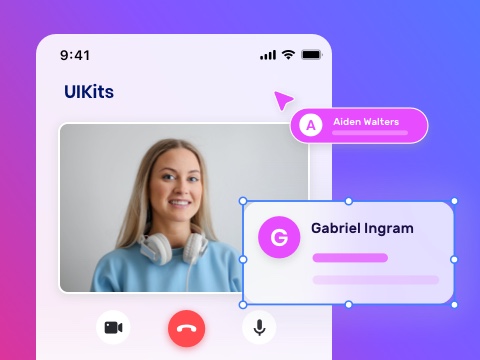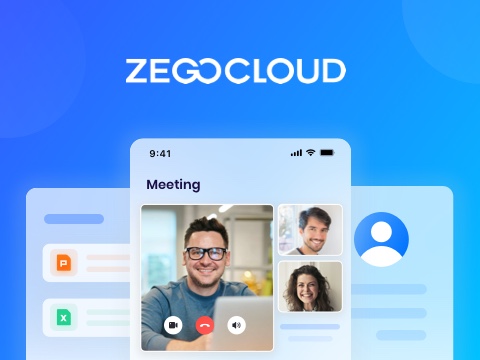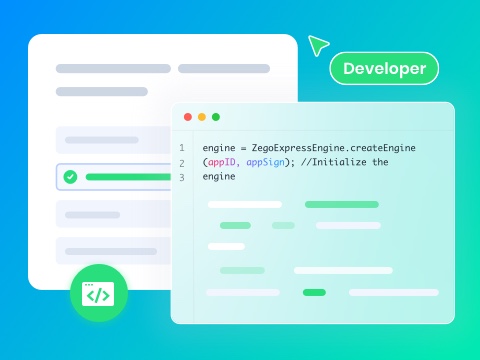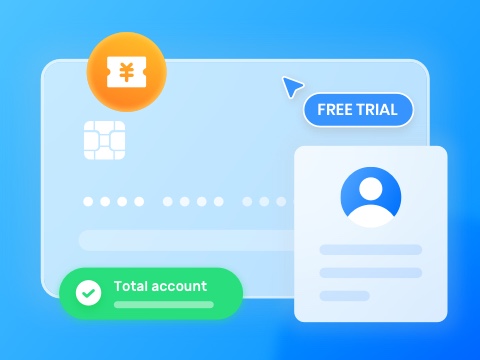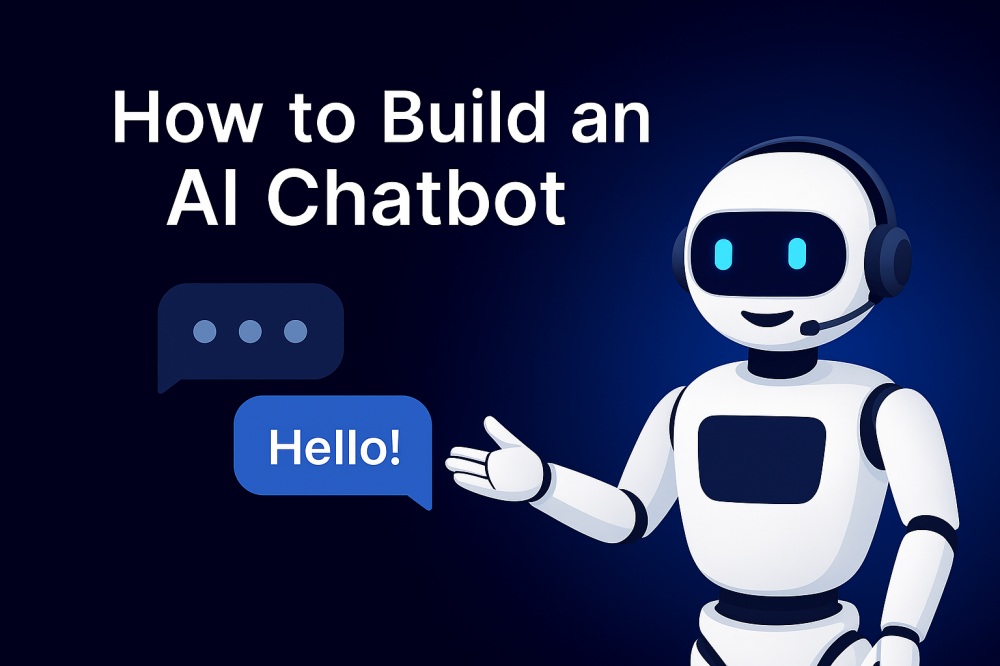To begin with, modern apps need intelligent chatbots that understand users and respond naturally. Therefore, whether you’re building customer support, educational tools, or interactive assistants, users now expect chatbots to handle both text messages and voice interactions seamlessly. In addition, this guide will walk you through how to build an AI chatbot with text and voice capabilities using ZEGOCLOUD. Step by step, you’ll learn how to create a responsive interface that works across devices, integrate real-time AI processing, and ultimately deploy a chatbot that feels natural, engaging, and responsive to users.
How to Make an AI Chatbot in Easy Steps
Traditionally, chatbot development often requires connecting multiple services, including natural language processing, text-to-speech, speech recognition, and real-time messaging. Moreover, each of these services demands separate integration, authentication, and error handling. As a result, ensuring both low latency and high reliability quickly becomes a complex challenge.
ZEGOCLOUD’s AI Agent platform simplifies this process with an all-in-one chatbot solution. Instead of juggling multiple integrations, you can build intelligent chatbots through a single SDK that seamlessly manages text conversations, processes voice input, and delivers natural speech responses. This approach not only reduces development complexity but also ensures a smoother, real-time experience for users.
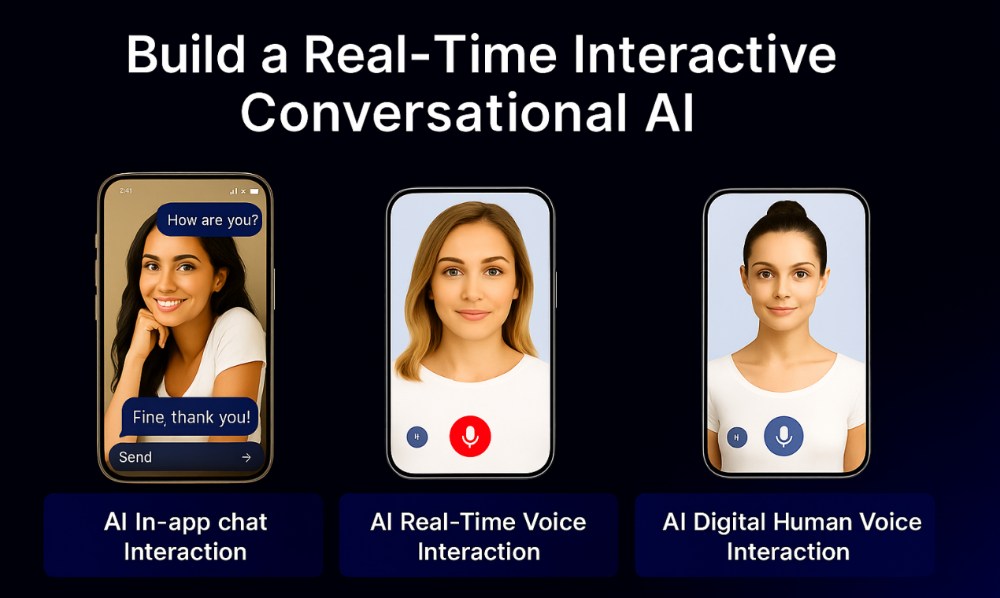
Prerequisites
Before you begin, gather these essential components:
- ZEGOCLOUD developer account with active AppID and ServerSecret from the console – Sign up here.
- Node.js 18+ installed locally for both backend and frontend development.
- OpenAI API key or compatible language model provider for intelligent responses.
- Code editor with TypeScript support for better development experience.
- Testing device with microphone access since chatbot voice features require actual hardware.
- Basic familiarity with React hooks and Express.js for building the user interface and API endpoints.
If you’ve met the prerequisites above, you can proceed with the steps below:
1. Project Setup and Configuration
Initialize the project structure that separates chatbot server logic from the user interface:
mkdir ai-chatbot
cd ai-chatbot
mkdir server clientInstall the required backend dependencies:
cd server
npm init -y
npm install express cors dotenv axios typescript tsx
npm install --save-dev @types/express @types/cors @types/nodeRename the .env.example file in the server directory to .env, then fill in the necessary values as instructed.
# ZEGOCLOUD Configuration
ZEGO_APP_ID=your_numeric_app_id
ZEGO_SERVER_SECRET=your_32_character_secret
ZEGO_API_BASE_URL=https://aigc-aiagent-api.zegotech.cn
# AI Model Configuration
DASHSCOPE_API_KEY=your_dashscope_api_key
# Server Settings
PORT=8080Create server/tsconfig.json:
{
"compilerOptions": {
"target": "ES2022",
"module": "ESNext",
"moduleResolution": "bundler",
"allowSyntheticDefaultImports": true,
"esModuleInterop": true,
"strict": true,
"outDir": "./dist",
"rootDir": "./src",
"declaration": true,
"sourceMap": true,
"resolveJsonModule": true
},
"include": ["src/**/*"],
"exclude": ["node_modules", "dist"]
}2. Chatbot Server Implementation
2.1 Authentication Tokens
The token endpoint generates secure authentication for chatbot users to join ZEGOCLOUD rooms:
app.get('/api/token', (req, res) => {
try {
const { user_id } = req.query
if (!user_id || typeof user_id !== 'string') {
return res.status(400).json({
success: false,
error: 'User ID required for chatbot session'
})
}
const token = generateToken04(
ZEGO_APP_ID,
user_id,
ZEGO_SERVER_SECRET,
7200, // 2 hours
''
)
res.json({
success: true,
token,
expires_in: 7200
})
} catch (error) {
res.status(500).json({
success: false,
error: 'Failed to generate chatbot token'
})
}
})2.2 Bot Registration
Bot registration configures the chatbot’s personality, response style, and processing capabilities:
async function registerAgent(): Promise<string> {
if (REGISTERED_AGENT_ID) return REGISTERED_AGENT_ID
const agentId = `agent_${Date.now()}`
const agentConfig = {
AgentId: agentId,
Name: 'AI Assistant',
LLM: {
Url: 'https://dashscope-intl.aliyuncs.com/compatible-mode/v1/chat/completions',
ApiKey: CONFIG.DASHSCOPE_API_KEY || 'zego_test',
Model: 'qwen-plus',
SystemPrompt: 'You are a helpful AI chatbot assistant. Be concise and friendly. Respond in the same language as the user. Keep responses under 100 words for better conversation flow.',
Temperature: 0.7,
TopP: 0.9,
Params: {
max_tokens: 200
}
},
TTS: {
Vendor: 'CosyVoice',
Params: {
app: { api_key: 'zego_test' },
payload: {
model: 'cosyvoice-v2',
parameters: {
voice: 'longxiaochun_v2',
speed: 1.0,
volume: 0.8
}
}
}
},
ASR: {
VADSilenceSegmentation: 1500,
PauseInterval: 2000
}
}
const result = await makeZegoRequest('RegisterAgent', agentConfig)
REGISTERED_AGENT_ID = agentId
return agentId
}The registration sets up a persistent chatbot that can handle multiple conversation sessions with consistent personality and voice characteristics.
2.3 Session Initialization
Session creation connects users with chatbot instances inside ZEGOCLOUD rooms:
app.post('/api/chatbot/start', async (req, res) => {
try {
const { room_id, user_id } = req.body
if (!room_id || !user_id) {
return res.status(400).json({
success: false,
error: 'Room ID and User ID required for chatbot'
})
}
const agentId = await registerAgent()
const instanceConfig = {
AgentId: agentId,
UserId: user_id,
RTC: {
RoomId: room_id,
AgentUserId: `chatbot_${room_id}`,
AgentStreamId: `chatbot_stream_${room_id}`,
UserStreamId: `${user_id}_stream`
},
MessageHistory: {
SyncMode: 1,
Messages: [],
WindowSize: 10
},
CallbackConfig: {
ASRResult: 1,
LLMResult: 1,
Exception: 1,
UserSpeakAction: 1,
AgentSpeakAction: 1
}
}
const result = await makeZegoRequest('CreateAgentInstance', instanceConfig)
res.json({
success: true,
chatbotId: result.Data?.AgentInstanceId,
room_id,
user_id
})
} catch (error) {
res.status(500).json({
success: false,
error: 'Failed to start chatbot session'
})
}
})Each session creates an isolated chatbot instance that maintains conversation context and handles real-time communication.
2.4 Session Termination
Clean session termination stops the chatbot instance and releases resources:
app.post('/api/chatbot/stop', async (req, res) => {
try {
const { chatbot_id } = req.body
if (!chatbot_id) {
return res.status(400).json({
success: false,
error: 'Chatbot ID required'
})
}
await makeZegoRequest('DeleteAgentInstance', {
AgentInstanceId: chatbot_id
})
res.json({
success: true,
message: 'Chatbot session stopped'
})
} catch (error) {
res.status(500).json({
success: false,
error: 'Failed to stop chatbot'
})
}
})Proper session termination prevents resource leaks and ensures clean chatbot lifecycle management. You can get the complete server code here.
3. Frontend Interface with Vite
Configure the React frontend for the chatbot interface:
cd ../client
npm create vite@latest . -- --template react-ts
npm install zego-express-engine-webrtc axios framer-motion lucide-react tailwindcss zodCreate Vite configuration in client/vite.config.ts:
import { defineConfig } from 'vite'
import react from '@vitejs/plugin-react'
import tailwindcss from '@tailwindcss/vite'
export default defineConfig({
plugins: [react(), tailwindcss()],
define: {
global: 'globalThis',
},
optimizeDeps: {
include: ['zego-express-engine-webrtc'],
}
})Set up environment variables in client/.env:
VITE_ZEGO_APP_ID=your_numeric_app_id
VITE_ZEGO_SERVER=wss://webliveroom-api.zegocloud.com/ws
VITE_API_BASE_URL=http://localhost:80804. ZEGOCLOUD Integration
4.1 Service Initialization
We create a singleton service (ChatbotZegoService) that sets up the ZEGOCLOUD engine once, prepares an audio element for playback, and registers event listeners to handle incoming messages and streams.
export class ChatbotZegoService {
private static instance: ChatbotZegoService
private zg: ZegoExpressEngine | null = null
private messageCallback: ((message: any) => void) | null = null
private audioElement: HTMLAudioElement | null = null
private currentRoomId: string | null = null
private currentUserId: string | null = null
private localStream: MediaStream | null = null
static getInstance(): ChatbotZegoService {
if (!ChatbotZegoService.instance) {
ChatbotZegoService.instance = new ChatbotZegoService()
}
return ChatbotZegoService.instance
}
async initialize(appId: string, server: string): Promise<void> {
this.zg = new ZegoExpressEngine(parseInt(appId), server)
this.setupEventListeners()
this.setupAudioElement()
}
private setupAudioElement(): void {
this.audioElement = document.getElementById('chatbot-audio') as HTMLAudioElement
if (!this.audioElement) {
this.audioElement = document.createElement('audio')
this.audioElement.id = 'chatbot-audio'
this.audioElement.autoplay = true
this.audioElement.controls = false
this.audioElement.style.display = 'none'
document.body.appendChild(this.audioElement)
}
this.audioElement.volume = 0.8
this.audioElement.muted = false
}
}4.2 Room Management
This part handles joining a room, authenticating with ZEGOCLOUD, and publishing the user’s local audio stream so they can participate in the conversation.
async joinRoom(roomId: string, userId: string, token: string): Promise<boolean> {
if (!this.zg) return false
try {
this.currentRoomId = roomId
this.currentUserId = userId
// Join the ZEGOCLOUD room with authentication
await this.zg.loginRoom(roomId, token, {
userID: userId,
userName: userId
})
// Enable message reception for chatbot communication
this.zg.callExperimentalAPI({
method: 'onRecvRoomChannelMessage',
params: {}
})
// Create local stream for voice input
const localStream = await this.zg.createZegoStream({
camera: { video: false, audio: true }
})
if (localStream) {
this.localStream = localStream
await this.zg.startPublishingStream(`${userId}_stream`, localStream)
return true
}
throw new Error('Failed to create local stream')
} catch (error) {
console.error('Failed to join room:', error)
return false
}
}4.3 Message Handling
All incoming ZEGOCLOUD messages are captured, parsed, and passed to a callback so the app can display or process them.
private setupEventListeners(): void {
this.zg?.on('recvExperimentalAPI', (result: any) => {
const { method, content } = result
if (method === 'onRecvRoomChannelMessage') {
try {
const message = JSON.parse(content.msgContent)
this.handleRoomMessage(message)
} catch (error) {
console.error('Failed to parse room message:', error)
}
}
})
}
private handleRoomMessage(message: any): void {
if (this.messageCallback) {
this.messageCallback(message)
}
}
onMessage(callback: (message: any) => void): void {
this.messageCallback = callback
}4.4 Audio Stream Management
Here we manage audio playback: creating an audio element, attaching remote streams, and controlling how chatbot voice responses are played.
this.zg?.on('roomStreamUpdate', async (roomID, updateType, streamList) => {
if (updateType === 'ADD' && streamList.length > 0) {
for (const stream of streamList) {
// Skip user's own stream to prevent feedback
if (stream.streamID !== `${this.currentUserId}_stream`) {
try {
const mediaStream = await this.zg?.startPlayingStream(stream.streamID)
if (mediaStream && this.audioElement) {
const remoteView = await this.zg?.createRemoteStreamView(mediaStream)
await remoteView?.play(this.audioElement, {
enableAutoplayDialog: false,
muted: false
})
this.audioElement.volume = 0.8
}
} catch (error) {
console.error('Failed to play chatbot audio:', error)
}
}
}
} else if (updateType === 'DELETE') {
if (this.audioElement) {
this.audioElement.srcObject = null
}
}
})4.5 Voice Input Control
This optional part lets us enable or disable the user’s microphone dynamically by toggling the local audio track.
async enableVoiceInput(enabled: boolean): Promise<boolean> {
if (!this.localStream) return false
try {
const audioTrack = this.localStream.getAudioTracks()[0]
if (audioTrack) {
audioTrack.enabled = enabled
return true
}
return false
} catch (error) {
console.error('Failed to toggle voice input:', error)
return false
}
}You get the complete ZEGOCLOUD integration codes here.
5. Chat Services
5.1 Configuration and Environment Validation
The frontend uses Zod for environment validation and service abstractions for comprehensive backend communication:
// client/src/config.ts
import { z } from 'zod'
const configSchema = z.object({
ZEGO_APP_ID: z.string().min(1, 'ZEGO App ID is required'),
ZEGO_SERVER: z.string().url('Valid ZEGO server URL required'),
API_BASE_URL: z.string().url('Valid API base URL required'),
})
const rawConfig = {
ZEGO_APP_ID: import.meta.env.VITE_ZEGO_APP_ID,
ZEGO_SERVER: import.meta.env.VITE_ZEGO_SERVER,
API_BASE_URL: import.meta.env.VITE_API_BASE_URL,
}
export const config = configSchema.parse(rawConfig)5.2 Backend Communication Layer
The API service provides clean interfaces for all chatbot operations:
// client/src/services/api.ts
import axios from 'axios'
import { config } from '../config'
const api = axios.create({
baseURL: config.API_BASE_URL,
timeout: 30000,
headers: { 'Content-Type': 'application/json' }
})
export const chatbotAPI = {
async startChatbot(roomId: string, userId: string) {
const response = await api.post('/api/chatbot/start', {
room_id: roomId,
user_id: userId,
user_stream_id: `${userId}_stream`,
})
return { chatbotId: response.data.chatbotId }
},
async sendMessage(chatbotId: string, message: string) {
await api.post('/api/chatbot/message', {
chatbot_id: chatbotId,
message: message.trim()
})
},
async getToken(userId: string) {
const response = await api.get(`/api/token?user_id=${encodeURIComponent(userId)}`)
return { token: response.data.token }
},
async stopChatbot(chatbotId: string) {
await api.post('/api/chatbot/stop', {
chatbot_id: chatbotId
})
}
}5.3 Conversation Memory Management
The memory service handles conversation persistence using localStorage with sophisticated metadata management and conversation lifecycle operations:
// client/src/services/memory.ts
class ChatbotMemoryService {
private static instance: ChatbotMemoryService
private conversations: Map<string, ConversationMemory> = new Map()
static getInstance(): ChatbotMemoryService {
if (!ChatbotMemoryService.instance) {
ChatbotMemoryService.instance = new ChatbotMemoryService()
}
return ChatbotMemoryService.instance
}
constructor() {
this.loadFromStorage()
}
private loadFromStorage(): void {
try {
const stored = localStorage.getItem('chatbot_conversations')
if (stored) {
const conversations = JSON.parse(stored)
conversations.forEach(conv => {
this.conversations.set(conv.id, conv)
})
}
} catch (error) {
console.error('Failed to load conversations from storage:', error)
}
}
private saveToStorage(): void {
try {
const conversations = Array.from(this.conversations.values())
localStorage.setItem('chatbot_conversations', JSON.stringify(conversations))
} catch (error) {
console.error('Failed to save conversations to storage:', error)
}
}
createOrGetConversation(id?: string): ConversationMemory {
const conversationId = id || this.generateConversationId()
if (this.conversations.has(conversationId)) {
return this.conversations.get(conversationId)!
}
const newConversation: ConversationMemory = {
id: conversationId,
title: 'New Chat Session',
messages: [],
createdAt: Date.now(),
updatedAt: Date.now(),
metadata: {
totalMessages: 0,
lastBotResponse: '',
topics: [],
averageResponseTime: 0
}
}
this.conversations.set(conversationId, newConversation)
this.saveToStorage()
return newConversation
}
addMessage(conversationId: string, message: ChatMessage): void {
const conversation = this.conversations.get(conversationId)
if (!conversation) return
// Handle message updates or additions
const existingIndex = conversation.messages.findIndex(m => m.id === message.id)
if (existingIndex >= 0) {
conversation.messages[existingIndex] = message
} else {
conversation.messages.push(message)
}
// Update conversation metadata
conversation.updatedAt = Date.now()
conversation.metadata.totalMessages = conversation.messages.length
if (message.sender === 'bot') {
conversation.metadata.lastBotResponse = message.content
}
// Auto-generate conversation title from first user message
if (conversation.messages.length === 1 && message.sender === 'user') {
conversation.title = message.content.slice(0, 50) + (message.content.length > 50 ? '...' : '')
}
this.saveToStorage()
}
getAllConversations(): ConversationMemory[] {
return Array.from(this.conversations.values())
.sort((a, b) => b.updatedAt - a.updatedAt)
}
private generateConversationId(): string {
return `chat_${Date.now()}_${Math.random().toString(36).substr(2, 9)}`
}
}
export const memoryService = ChatbotMemoryService.getInstance()6. Main Chatbot Component
6.1 Component Architecture
Before implementing the chatbot interface, understanding the system architecture helps coordinate the different layers:
The architecture separates concerns:
- React manages UI state and user interactions.
- ZEGOCLOUD handles real-time communication and AI processing, and
- The backend manages authentication and session lifecycle.
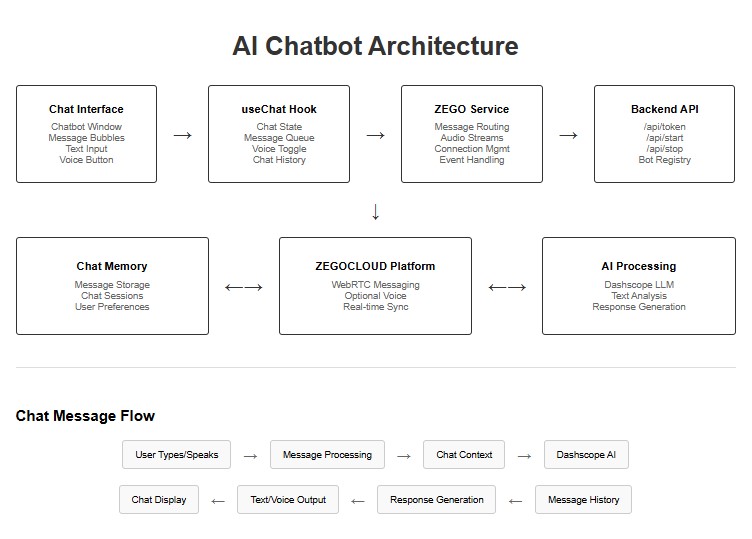
6.2 Main Chatbot component
The main chatbot component coordinates all functionality:
export const Chatbot = () => {
const [messages, setMessages] = useState<ChatMessage[]>([])
const [session, setSession] = useState<ChatbotSession | null>(null)
const [isConnected, setIsConnected] = useState(false)
const [botStatus, setBotStatus] = useState<'idle' | 'listening' | 'thinking' | 'speaking'>('idle')
const zegoService = useRef(ChatbotZegoService.getInstance())
useEffect(() => {
setupMessageHandlers()
}, [])
const setupMessageHandlers = () => {
zegoService.current.onMessage((data: any) => {
const { Cmd, Data: msgData } = data
if (Cmd === 3) { // Voice transcript
const { Text: transcript, EndFlag } = msgData
if (EndFlag && transcript?.trim()) {
addMessage({
id: `voice_${Date.now()}`,
content: transcript.trim(),
sender: 'user',
timestamp: Date.now(),
type: 'voice'
})
}
} else if (Cmd === 4) { // Bot response
const { Text: content, MessageId, EndFlag } = msgData
if (EndFlag) {
updateMessage(MessageId, content, false)
} else {
addStreamingMessage(MessageId, content)
}
}
})
}
const startChatbot = async () => {
const roomId = `chatbot_${Date.now()}`
const userId = `user_${Date.now()}`
const { token } = await chatbotAPI.getToken(userId)
await zegoService.current.joinRoom(roomId, userId, token)
const { chatbotId } = await chatbotAPI.startChatbot(roomId, userId)
setSession({ roomId, userId, chatbotId, isActive: true, voiceEnabled: true })
setIsConnected(true)
}
return (
<div className="flex flex-col h-screen bg-gray-50">
{/* Chat messages display */}
<div className="flex-1 overflow-y-auto px-4 py-6">
{messages.map(message => (
<MessageBubble key={message.id} message={message} />
))}
</div>
{/* Input interface */}
{isConnected && (
<div className="bg-white border-t border-gray-200 p-4">
<div className="flex items-center space-x-3">
<input
type="text"
placeholder="Type your message..."
className="flex-1 px-4 py-3 border border-gray-300 rounded-xl focus:outline-none focus:ring-2 focus:ring-purple-500"
/>
<button className="p-3 bg-purple-600 text-white rounded-xl hover:bg-purple-700">
<Send className="w-5 h-5" />
</button>
</div>
</div>
)}
</div>
)
}The component manages the chatbot lifecycle, handles real-time messages, and provides an interactive interface for users to communicate with the AI chatbot.
7. Application Integration
7.1 Complete Implementation
The full chatbot implementation with all components, configuration files, and deployment setup is available in the GitHub repository. The repository includes the complete server implementation, React components, styling, and production deployment configurations. So, you can clone it to run the demo or modify as needed.
7.2 Running the Chatbot
Start both servers to test the complete chatbot system:
Backend Server:
cd server
npm run devFrontend Application:
cd client
npm run devRun a Demo
Conclusion
Now you have a working AI chatbot that can understand speech, respond intelligently, and manage real-time conversations. Users are free to type or speak naturally, and the chatbot delivers appropriate replies in text or voice.
What once required complex integrations of multiple AI services, audio processing pipelines, and real-time synchronization has been made simple with ZEGOCLOUD. With a single platform, you built a chatbot that feels both responsive and natural to use.
This solid foundation can power customer support, education, virtual assistants, or any application where intelligent conversation is essential. From here, you can refine the chatbot’s personality, extend its features, or integrate with external services while maintaining the same reliable communication core.
FAQ
Q1: Can I make my own AI chatbot?
Yes. With platforms like ZEGOCLOUD, you can build an AI chatbot that handles both text and voice interactions. The process no longer requires stitching together multiple services, so even individual developers can create powerful chatbots.
Q2: How much does it cost to build an AI chatbot?
The cost depends on scale and features. Simple chatbots can be built at low cost, while advanced real-time conversational bots may require cloud usage fees. ZEGOCLOUD offers flexible pricing so you can start small and scale as your user base grows.
Q3: Can I create my own AI like ChatGPT?
You can build applications powered by large language models similar to ChatGPT, but instead of training one from scratch, most developers integrate existing APIs and SDKs. This saves time, cost, and computing resources.
Q4: Is it hard to develop an AI chatbot?
Traditionally it was difficult because you had to integrate natural language processing, speech recognition, text-to-speech, and real-time messaging. With ZEGOCLOUD’s all-in-one AI agent SDK, the process is much easier and faster.
Let’s Build APP Together
Start building with real-time video, voice & chat SDK for apps today!


